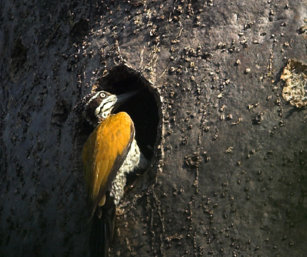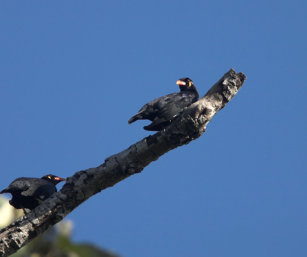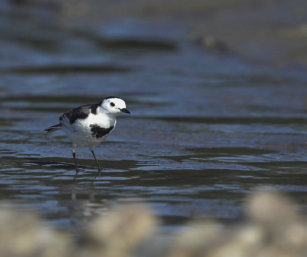Nameri, Dec 2005
Part of Assam trip that included Kaziranga “White Wing wood duck… White Wing wood duck… White Wing wood duck…” it is almost like an oft repeated mantra in Nameri. Even the nearby locals here would come up and ask you, “Wood duck dekha?” (Did you see the wood duck?). That is when you realize that this bird is not just another bird… but one that is truly venerated not because it is any avtar (incarnation) of a God; that it is truly adored not because it has any good looks; that it is truly valued not because it brings them any monetary benefit… but sheerly because there are only 250 of them left in this world! The locals and the forest department know that it is their prized possession and they protect it ardently.
If you are birder then Nameri is a paradise. Nameri National Park and Tiger Reserve (200sq.km), an obscure, little-known destination, in the northern edge of Assam was declared a National Park as late as 1998. A two-hour (38km) drive from Tezpur or a six-hour (250km) drive from the more popular Guwahati will take one to Nameri. The Park is drained by the river Jia-Bhoroli and its tributaries, which swell to dangerous levels during the incessant downpour of the monsoon. The Pakhui Sanctuary of Arunachal Pradesh is contiguous to this Park on its North-Eastern boundary. The inaccessibility and continuity with the neighbouring forest areas have helped the wildlife of Nameri to thrive.
Our visit to Nameri was in the beginning of December, which is one of the better periods for birding, especially to see rarities like the Ibisbill and Long-billed plover and other winter migrants like the Pied harrier, Grey-backed shrike, Greater-spotted eagle etc. We stayed at the Eco-Camp, a tented camp with basic yet comfortable facilities and delightful service. The large green army tents are set on concrete platforms and have a thatched roof overhead. Single beds made of thick bamboo frames appointed with warm quilts invite you to the interior of the tent. Adjacent to the back of the tent is the changing area with a sink and a little tin door on the side takes you to the toilet (western) and shower area.
The Eco-Camp was set up in 1994 by the local Forest Department (Wildlife) and The Assam (Jia-Bhoroli) Angling and Conservation Association. And just as most government set-ups, though it had a fair amount of loyal clientele, this also was run-down till the current manager Ronesh Roy took up the responsibility of the Camp’s Director. Today he, with his signature cigarette smoke trail behind, is a ubiquitous figure in the Camp and has turned it around to becoming a profitable and popular venture. Ronesh has involved the locals especially the youngsters of the Mising tribe in his venture. He employs them in as river-guides, house-keeping, f&b etc.
They have also been encouraged to take up bird-watching and many of them have learnt a lot from the bird books given to them by Ronesh. The Camp is well-frequented by anglers from Kolkata for the waters of Jia-Bhoroli next-door are home to the endangered Golden Mahseer and the Short-gilled Mahseer. Activities one can do in Nameri are trekking, angling and rafting on the Jhia-Borelli. While trekking trails are not too long and are usually birding trails, rafting is very exciting and can also be very productive for the hard core birder.
Ibisbills, long-billed plovers, common mergansers, water redstarts, colonies of large cormorants and bar-headed geese are usually found on the shingle banks of the river. We took a day long rafting trip from a point about 15 kms upstream to Eco Camp. The scenery was beautiful with evergreen forests on both sides and snow-capped peaks of the Arunachal Himalaya on the North. Midway through the trip we beached and the guides made a fantastic lunch.































